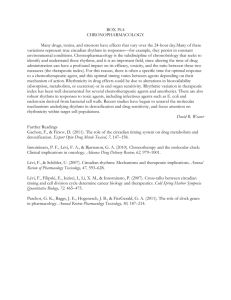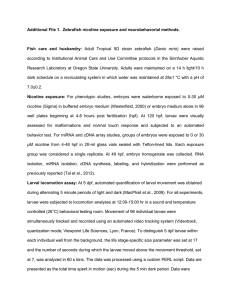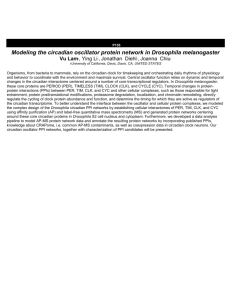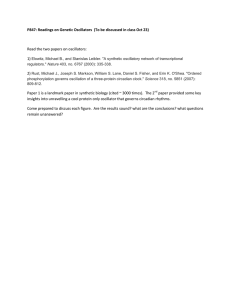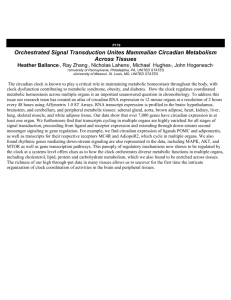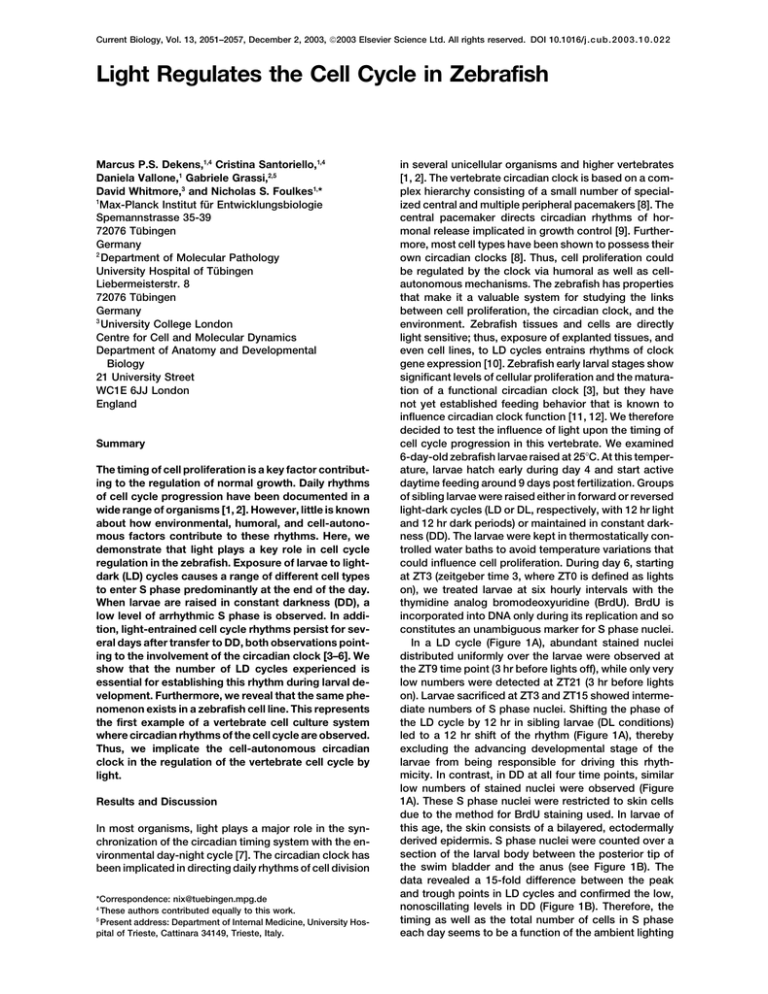
Current Biology, Vol. 13, 2051–2057, December 2, 2003, 2003 Elsevier Science Ltd. All rights reserved. DOI 10.1016/j.cub.2003.10.022
Light Regulates the Cell Cycle in Zebrafish
Marcus P.S. Dekens,1,4 Cristina Santoriello,1,4
Daniela Vallone,1 Gabriele Grassi,2,5
David Whitmore,3 and Nicholas S. Foulkes1,*
1
Max-Planck Institut für Entwicklungsbiologie
Spemannstrasse 35-39
72076 Tübingen
Germany
2
Department of Molecular Pathology
University Hospital of Tübingen
Liebermeisterstr. 8
72076 Tübingen
Germany
3
University College London
Centre for Cell and Molecular Dynamics
Department of Anatomy and Developmental
Biology
21 University Street
WC1E 6JJ London
England
Summary
The timing of cell proliferation is a key factor contributing to the regulation of normal growth. Daily rhythms
of cell cycle progression have been documented in a
wide range of organisms [1, 2]. However, little is known
about how environmental, humoral, and cell-autonomous factors contribute to these rhythms. Here, we
demonstrate that light plays a key role in cell cycle
regulation in the zebrafish. Exposure of larvae to lightdark (LD) cycles causes a range of different cell types
to enter S phase predominantly at the end of the day.
When larvae are raised in constant darkness (DD), a
low level of arrhythmic S phase is observed. In addition, light-entrained cell cycle rhythms persist for several days after transfer to DD, both observations pointing to the involvement of the circadian clock [3–6]. We
show that the number of LD cycles experienced is
essential for establishing this rhythm during larval development. Furthermore, we reveal that the same phenomenon exists in a zebrafish cell line. This represents
the first example of a vertebrate cell culture system
where circadian rhythms of the cell cycle are observed.
Thus, we implicate the cell-autonomous circadian
clock in the regulation of the vertebrate cell cycle by
light.
Results and Discussion
In most organisms, light plays a major role in the synchronization of the circadian timing system with the environmental day-night cycle [7]. The circadian clock has
been implicated in directing daily rhythms of cell division
*Correspondence: nix@tuebingen.mpg.de
4
These authors contributed equally to this work.
5
Present address: Department of Internal Medicine, University Hospital of Trieste, Cattinara 34149, Trieste, Italy.
in several unicellular organisms and higher vertebrates
[1, 2]. The vertebrate circadian clock is based on a complex hierarchy consisting of a small number of specialized central and multiple peripheral pacemakers [8]. The
central pacemaker directs circadian rhythms of hormonal release implicated in growth control [9]. Furthermore, most cell types have been shown to possess their
own circadian clocks [8]. Thus, cell proliferation could
be regulated by the clock via humoral as well as cellautonomous mechanisms. The zebrafish has properties
that make it a valuable system for studying the links
between cell proliferation, the circadian clock, and the
environment. Zebrafish tissues and cells are directly
light sensitive; thus, exposure of explanted tissues, and
even cell lines, to LD cycles entrains rhythms of clock
gene expression [10]. Zebrafish early larval stages show
significant levels of cellular proliferation and the maturation of a functional circadian clock [3], but they have
not yet established feeding behavior that is known to
influence circadian clock function [11, 12]. We therefore
decided to test the influence of light upon the timing of
cell cycle progression in this vertebrate. We examined
6-day-old zebrafish larvae raised at 25⬚C. At this temperature, larvae hatch early during day 4 and start active
daytime feeding around 9 days post fertilization. Groups
of sibling larvae were raised either in forward or reversed
light-dark cycles (LD or DL, respectively, with 12 hr light
and 12 hr dark periods) or maintained in constant darkness (DD). The larvae were kept in thermostatically controlled water baths to avoid temperature variations that
could influence cell proliferation. During day 6, starting
at ZT3 (zeitgeber time 3, where ZT0 is defined as lights
on), we treated larvae at six hourly intervals with the
thymidine analog bromodeoxyuridine (BrdU). BrdU is
incorporated into DNA only during its replication and so
constitutes an unambiguous marker for S phase nuclei.
In a LD cycle (Figure 1A), abundant stained nuclei
distributed uniformly over the larvae were observed at
the ZT9 time point (3 hr before lights off), while only very
low numbers were detected at ZT21 (3 hr before lights
on). Larvae sacrificed at ZT3 and ZT15 showed intermediate numbers of S phase nuclei. Shifting the phase of
the LD cycle by 12 hr in sibling larvae (DL conditions)
led to a 12 hr shift of the rhythm (Figure 1A), thereby
excluding the advancing developmental stage of the
larvae from being responsible for driving this rhythmicity. In contrast, in DD at all four time points, similar
low numbers of stained nuclei were observed (Figure
1A). These S phase nuclei were restricted to skin cells
due to the method for BrdU staining used. In larvae of
this age, the skin consists of a bilayered, ectodermally
derived epidermis. S phase nuclei were counted over a
section of the larval body between the posterior tip of
the swim bladder and the anus (see Figure 1B). The
data revealed a 15-fold difference between the peak
and trough points in LD cycles and confirmed the low,
nonoscillating levels in DD (Figure 1B). Therefore, the
timing as well as the total number of cells in S phase
each day seems to be a function of the ambient lighting
Current Biology
2052
Figure 1. Light Cycles Regulate the Timing
of S Phase in Zebrafish Larval Skin
(A) Whole-mount staining for BrdU incorporation in 6-day-old zebrafish larvae raised at
25⬚C under normal light-dark cycles (LD), reversed light-dark cycles (DL), or constant
darkness (DD). Three hours after “lights on”
for the LD larvae (zeitgeber time [ZT] ⫽ 3)
larvae were incubated for 20 min with BrdU.
This corresponded to ZT ⫽ 15 for the DL larvae. Larvae at the same time point in DD were
also labeled. This procedure was repeated at
three additional time points at 6 hr intervals.
(B) Quantification of BrdU-positive nuclei
from the experiment shown in (A). At each
time point, the mean number of positive skin
nuclei lying between the posterior tip of the
swim bladder and the anus calculated from
10 larvae per experiment (y axis) was plotted
against ZT time (x axis) for LD (white bar), DL
(gray bar), and DD (black bar). A horizontal
white and black bar below the x axis denotes
the light and dark periods. Below is shown
a representative zebrafish larva stained for
BrdU incorporation where two lines delimit
the region in which nuclei were counted. Differences between peak and trough points for
the LD and DL cycles are highly significant
(p ⬍⬍ 0.0001). Differences between DD values were not significant (p ⱖ 0.39).
(C) Mean numbers of BrdU-labeled nuclei
from larvae raised in LD conditions but labeled each 2 hr during a 24 hr time course.
x axis values represent ZT time.
conditions. These observations imply that exposure of
zebrafish to LD cycles might constitute a mitogenic stimulus. A higher-resolution analysis was performed, labeling LD larvae each 2 hr (Figure 1C). The results of this
analysis show that the period of elevated S phase lasts
for approximately 8 hr with a peak 3 hr before the end
of the day. Interestingly, in certain unicellular organisms,
S phase is also timed to occur at the end of the day or
during the night [13]. This has led to the hypothesis that
the adaptive significance of daily timing of the cell cycle
is to avoid DNA damage induced by UV radiation in
sunlight during the critical step of DNA replication [13].
Light Regulates the Cell Cycle in Zebrafish
2053
Time-of-day-dependent changes in the spectral composition of sunlight penetrating water may result in the
observed late afternoon increase in S phase correlating
with low UV exposure [14]. Alternatively, entry into S
phase at the end of the day could ensure the appropriate
timing of mitosis.
We wished to determine whether the light-directed
rhythm of S phase was only a skin-cell-specific property.
Therefore, we selected tissues derived from two other
embryonic germ layers: the heart and the gut. The heart
has been previously reported to contain a directly lightentrainable circadian clock [10] and, contrary to the skin,
would be predicted to show low levels of cell proliferation. BrdU labeling of the hearts dissected from 6-dayold larvae raised in a LD cycle revealed a rhythm of S
phase nuclei that was similar in timing to that documented in the skin but with a significantly lower amplitude (Figures 2A and 2B). In the gut, a high-amplitude
rhythm of S phase was detected similar to that seen in
the skin (data not shown). The presence of BrdU-labeled
nuclei in these organs strongly suggests that this phenomenon exists in various cell types. Thus, the timing
of cell proliferation in many tissues seems to be influenced by light. Interestingly, we have observed the highest-amplitude rhythms of S phase in tissues that manifest sustained high levels of cell proliferation and
regeneration, suggesting the importance of this temporal regulation under conditions of rapid cell turnover in
vivo. It is difficult to predict how changes in the rate of
cell proliferation in such tissues would alter how rapidly
they grow. However, it would be interesting to determine
whether fish raised for long periods in constant darkness
show reduced growth.
We next asked how this S phase rhythm is regulated.
The prediction for a purely light-driven process would
be that upon transfer to constant darkness, rhythmicity
would rapidly be abolished. We therefore tested the
persistence of light-entrained S phase rhythmicity in
embryos that were raised for 5 days in LD and DL cycles
and then transferred to DD. On the second and third
days after transfer to DD, embryos were labeled and
analyzed for BrdU incorporation (Figure 2C). Rhythmicity
in the numbers of S phase nuclei continued during the
time course of the analysis, although the amplitude of
this rhythm was significantly reduced on the third cycle.
Also, the period length of the S phase rhythm seems to
be slightly longer than 24 hr, leading to a progressive
shift of the peaks into the predicted subjective night
(Figure 2C). These results are entirely diagnostic of the
circadian timing system’s involvement in directing the
daily rhythms of cell cycle progression [4–6]. Furthermore, the arrhythmic S phase seen in larvae raised in
DD conditions is consistent with previous reports of
circadian clock outputs in zebrafish. Specifically, circadian rhythms of locomotor activity and melatonin release are not observed in zebrafish raised in constant
darkness [3, 15, 16]. One can speculate that coupling
cell cycle to the circadian clock might confer properties
such as temperature compensation on the cell cycle
[17]. Such a mechanism might dampen the influence of
environmental fluctuations on the levels of cell proliferation.
We next investigated when during development the
Figure 2. S Phase Rhythm in the Heart
(A) Representative hearts from 6-day-old, LD-entrained larvae sacrificed at the indicated ZT time points.
(B) Mean numbers of BrdU-positive nuclei calculated from ten hearts
per point per experiment plotted against ZT time. Values at the peak
points ZT9 and ZT15 are significantly different from the trough ZT21
point (p ⱕ 0.0001, indicated by ***). Differences between the ZT3
and ZT21 points are not significant.
(C) Light-entrained circadian clock regulates S phase in larvae raised
under a light-dark cycle. Mean numbers of BrdU-positive nuclei in
larvae raised for 5 days either in LD (white bars), DL (gray bars), or
DD (black bars) and then transferred for 3 days into DD. Larvae
were harvested at eight time points distributed over 48 hr at 6 hr
intervals, starting from the beginning of the second day in DD. The
gray and black bars below the graph denote the predicted duration
of subjective day and night. Differences between the peak and
trough points for both cycles following entrainment in LD and DL
are highly significant (p ⬍⬍ 0.0001). Differences between DD values
were not significant.
light-entrainable S phase rhythms first appeared. Prior
to day 4, no 24 hr rhythm was detected, and the distribution of positive nuclei tended to be nonuniform (data
not shown). Analysis of larvae raised in LD conditions
at 25⬚C on day 4 revealed a low-amplitude (2- to 3-fold)
Current Biology
2054
rhythm with nuclei uniformly distributed over the entire
body (Figure 3A). We then questioned whether the number of LD cycles experienced or the developmental
stage contributed to the amplitude of light-entrainable
S phase rhythms. Specifically, we tested whether accelerating development by raising the embryos at higher
temperatures led to an earlier appearance of a highamplitude rhythm. Initially, we raised sets of embryos
for 4 days at 25⬚C, 28⬚C, or 30⬚C in LD conditions. The
higher temperatures resulted in a significant acceleration of the rate of development and, consequently,
hatching was advanced to 2.5 days post fertilization in
28⬚C fish and 1.5 days in 30⬚C fish. Examination revealed
that the 4-day-old 28⬚C and 30⬚C larvae were comparable or slightly advanced in developmental stage relative
to 6-day-old 25⬚C fish (Figure 3B). The 4-day-old 30⬚C
larvae showed a low-amplitude S phase rhythm only
slightly increased relative to that of 4-day-old 25⬚C and
28⬚C larvae (Figure 3C). These results contrast with the
high-amplitude rhythm observed for 6-day-old larvae
raised at 25⬚C (Figure 3C). Finally, examination of 5-dayold larvae raised at 30⬚C confirmed that the characteristic increase in rhythm amplitude did subsequently occur
in the larvae raised at higher temperatures (Figure 3D).
These results indicate that the number of LD cycles
experienced and not the developmental stage is a major
factor determining the time of appearance of a highamplitude S phase rhythm. Circadian rhythms of clock
gene (zfperiod3) expression have been documented in
embryos raised in DD conditions and used as evidence
for maternal inheritance of the circadian clock [18]. Previous reports have documented that clock outputs in
the zebrafish such as rhythmic locomotor activity and
melatonin release are only established following previous exposure to LD cycles [3, 15, 16]. Our data would
tend to reinforce the notion that the development of
circadian clock outputs in zebrafish is tightly linked with
exposure to light cycles [3]. This could imply that the
mechanism coupling the clock with its outputs may be
directly affected by LD cycles.
We next wished to determine at which level light influences the timing of cell cycle progression. The activity
of the neuroendocrine axis is under central pacemaker
Figure 3. Influence of the Number of LD Cycles on the Increase in
the Amplitude of S Phase Rhythms during Development
(A) Mean numbers of BrdU-positive nuclei in 4-day old-larvae raised
in LD and DD conditions at 25⬚C (white and black bars, respectively).
Differences between the peak (ZT9) and trough points (ZT21) in LD
were significant (p ⬍ 0.0001, indicated by ***). Differences between
DD values were not significant.
(B) Images of 4-day-old BrdU-labeled larvae raised at 25⬚C, 28⬚C,
and 30⬚C compared with a 6-day-old larva raised at 25⬚C.
(C) Mean numbers of BrdU-positive nuclei in 4-day-old larvae raised
under LD conditions either at 25⬚C (black bars), 28⬚C (light gray
bars), or 30⬚C (dark gray bars). These are compared with the results
from 6-day-old larvae raised at 25⬚C (white bars). The peak values
at 25⬚C and 28⬚C in 4-day-old fish were not significantly different (p ⱖ
0.16). However, peak values of 25⬚C and 28⬚C were both significantly
different from 30⬚C (p ⱕ 0.0001).
(D) Mean numbers of BrdU-positive nuclei in larvae raised at 30⬚C
at 4 days old (dark gray bars) and 5 days old (white bars). Peak
values at ZT9 for day 4 and day 5 were significantly different (p ⬍
0.0001).
Light Regulates the Cell Cycle in Zebrafish
2055
Figure 4. Light Entrains Circadian Rhythms of S Phase Cell Autonomously
(A) ELISA assay results of BrdU incorporation in PAC-2 cells maintained under normal or reversed light-dark cycles (LD, white bars; DL, gray
bars). Both LD and DL optical density readings (OD450) are plotted together on the same x axis, and each time point is labeled with the ZT
time calculated relative to the LD cycle. White and black bars below show the timing of the light and dark periods for each cycle.
(B) ELISA data from cells maintained under DD conditions and harvested at the same time points as the LD and DL sets.
(C) FACS analysis of cells maintained under a LD cycle, labeled, and harvested at four time points. In each panel, dots represent single cells
and are plotted against an x axis, quantifying, on a linear scale, 7-AAD fluorescence (cellular DNA content), and against a y axis, quantifying
on a logarithmic scale, R-PE-conjugated BrdU antibody fluorescence (newly synthesized DNA). Quadrant II contains G0/G1 cells, S phase
cells lie between quadrants III and IV, and G2/M cells predominantly occupy quadrants I and IV.
(D) ELISA results from cells incubated for 5 days in DL and then transferred to DD for 1 day before harvesting during a 48 hr period in DD
(gray bars). Control cells were maintained under DL conditions up to and during the period of analysis (white bars).
For all ELISA and FACS results, differences between peak and trough values under light-dark cycles were highly significant (p ⬍⬍ 0.0001).
control [19]. By this mechanism, circadian rhythms of
hormone release direct many physiological processes
including growth [9]. Thus, the possibility that such hormonal signals might direct timing of the cell cycle in
zebrafish cannot be excluded. Alternatively, clock
components might directly control cell cycle regulatory
factors cell autonomously. Recently, the mPER2 clock
protein in mouse has been implicated as a tumor suppressor [20], and the direct regulation of cell cycle regulatory genes by clock components has been documented during hepatic regeneration in mouse [21]. In
order to determine the contribution of cell-autonomous
regulation, we examined the effect of light on cell cycle
progression in zebrafish embryo-derived cell cultures
that have been previously reported to contain a directly
light-entrainable circadian clock [10, 22]. This approach
also allowed us to confirm the involvement of the zebrafish circadian clock in regulating cell cycle progression
in a system more simple than the developing larva.
PAC-2 cell cultures were seeded at subconfluence and
exposed for 6 days to LD, DL, or DD conditions. The
culture medium was then supplemented with BrdU at
given time points and the number of labeled cells was
measured using an ELISA assay. When cultures were
exposed to LD cycles, they showed a robust 24 hr
rhythm of S phase cells with a peak at the light-dark
Current Biology
2056
transition, slightly later than that observed in the larvae.
This rhythm was phase shifted by 12 hr in cells exposed
to DL cycles (Figure 4A). A nonrhythmic profile was observed in cells maintained for an extended period in DD
conditions (Figure 4B). This result was also confirmed
by FACS analysis (Figure 4C). Cells were double labeled
with BrdU and the DNA dye 7-Amino-Actinomycin D
(7AAD), and subsequent sorting revealed the number of
cells in G0/G1, S, and G2/M phases of the cell cycle. By
this assay, the number of cells in S and G2/M phases
showed the same rhythm observed in the ELISA analysis
(Figure 4C and data not shown). As previously demonstrated in the zebrafish larvae, after transfer of LD- or
DL-adapted cells to DD, rhythmic BrdU incorporation
persisted on the second and third day with dampening
(Figure 4D). The properties of these rhythms in cells
cultured in the various LD and DD regimes are entirely
consistent with previous reports of rhythmic clock gene
expression in zebrafish cell lines maintained under
equivalent conditions. Rhythms of zfClock, zfperiod1,
zfperiod3, zfBMAL1, and zfBMAL2 mRNA expression
persist for 2 to 3 days after transfer from LD to DD, and
on the fourth day, expression patterns are randomized
[10, 22]. Our data strongly suggest a cell-autonomous
contribution of the circadian clock to the light-regulated
daily rhythms of S phase in zebrafish. Previously reported vertebrate cell culture models for the circadian
clock are less attractive for studying this aspect of cell
cycle regulation. Specifically, circadian clock rhythms
in mammalian cell lines are only induced by transient
exposure to either high serum concentrations or activators of various signaling pathways [23, 24]. All of these
treatments have profound effects on cell proliferation
independently of the circadian clock.
Conclusions
Here, we document a previously unknown facet of cell
cycle regulation in the zebrafish, a widely used vertebrate model organism. Our results reveal that direct exposure to visible light determines the timing of S phase.
Our observations strongly implicate the circadian
clock in mediating the effects of light on the cell cycle
in zebrafish. (1) After exposure to LD cycles, S phase
rhythms persist for several cycles upon transfer to constant darkness with a circadian period length [4–6]. (2)
We reveal a crucial requirement for LD cycles in establishing these rhythms during development: the presence
of arrhythmic S phase in larvae that have never been
exposed to light and the increase in amplitude of S
phase rhythms depending on the number of LD cycles
experienced. This is consistent with previous reports
documenting the maturation of other zebrafish clock
outputs [3, 15, 16]. (3) Similar rhythms can be entrained
by LD cycles in a zebrafish embryo-derived cell line and
have properties that match well with previous reports
of rhythmic clock gene expression in these cell cultures
[10, 22].
The availability of cell lines with a light-entrainable
clock gives the zebrafish a distinct advantage over other
vertebrate models for studying the role of the circadian
clock in the regulation of the cell cycle. For the first time,
using these cells we have implicated a cell autonomous
contribution of the circadian clock in generating rhythms
of cell cycle progression.
Experimental Procedures
Raising Zebrafish Larvae
The zebrafish Tübingen strain was maintained and crossed according to standard methods. Fertilized eggs were collected within
2 hr of laying and rinsed well, and aliquots of 35 were transferred
into 20 ml of E3 buffer [25] in 25cm2 tissue culture flasks. Flasks
were sealed and then submerged horizontally in large-volume, thermostatically controlled water baths to maintain a constant temperature. Larvae were illuminated with a tungsten light source (11W/
cm2) connected to a programmable timer.
BrdU Labeling of Larvae
Larvae were incubated for 20 min in E3 buffer with a final concentration of 10 mM BrdU. Fixing and staining for BrdU incorporation was
performed as described elsewhere [25]. To visualize BrdU incorporation of internal structures, 6-day-old larvae were bisected prior to
the staining procedure followed by dissection of the organs. The
mean and standard deviation of the number of positive nuclei were
calculated, and single factor Anova analysis was used to assess
statistical significance.
Cell Culture, ELISA, and FACS Assays
The establishment of the PAC-2 cell line has already been reported
[26]. They were derived from 24-hr-old wild-type zebrafish embryos,
and their growth properties indicate a fibroblast origin. Culture conditions were as previously described [10]. Cultures were illuminated
while immersed in large-volume (60 liter), thermostatically controlled
water baths with a tungsten light source (11 W/cm2) connected to
a programmable timer.
A Biotrak cell proliferation ELISA assay kit (Amersham) was used
to quantify BrdU incorporation. 1.5 ⫻ 104 cells per well were seeded
in a 96-multiwell plate and incubated with 10 M BrdU for 2 hr. They
were then processed as recommended by the manufacturer. Plates
were finally assayed on a multiwell plate reader (Sunrise reader,
Tecan). Addition of BrdU to the culture medium during dark periods
was performed under dim red light. For each experimental time
point (minimum 16 wells), the mean OD450 measurement plus the
standard deviation was calculated. Single-factor Anova analysis
was used to assess the statistical significance of differences between peak and trough points.
For FACS analysis, after 2 hr labeling with 10 M BrdU, 1 ⫻ 106
cells were harvested and DNA stained using 7-AAD (Via-PROBE,
Becton Dickinson) and a R-PE-conjugated anti-BrdU antibody (Becton Dickinson) according to the manufacturer’s instructions. Background fluorescence for the anti-BrdU antibody was assessed with
an aliquot of cells stained by an R-PE-conjugated isotype control
antibody (Becton Dickinson). FACS analysis was performed using
a Becton Dickinson FACScalibur machine and data analyzed using
Cellquest software.
Acknowledgments
We would like to thank Christiane Nüsslein-Volhard, Ferenc Müller,
and Thomas Dickmeis for critical reading of this manuscript and for
many helpful discussions. We are grateful to Mahendra Sonawane,
Srinivas Babu Gondi, and Kajori Lahiri for help and discussions. We
thank Andreas Heyd for expert technical help. We thank Professor
R. Kandolf for generously providing access to the FACS analysis
facility. This work was supported by funds and fellowships from the
Max-Planck society, CNRS (France), and the Dr. Karl-Kuhn-Stiftung,
Ausschuttung aus dem Stiftungsertrag 2001. N.S.F. participated in
a joint CNRS (France)/Max-Planck Society exchange program. For
part of this work, M.P.S.D. was supported by personal funds. D.W.
was supported by funding from the BBSRC and Wellcome trust.
Received: September 11, 2003
Revised: October 1, 2003
Accepted: October 8, 2003
Published online: October 16, 2003
Light Regulates the Cell Cycle in Zebrafish
2057
References
1. Bjarnason, G.A., and Jordan, R. (2000). Circadian variation of
cell proliferation and cell cycle protein expression in man: clinical implications. Prog. Cell Cycle Res. 4, 193–206.
2. Mori, T., and Johnson, C.H. (2000). Circadian control of cell
division in unicellular organisms. Prog. Cell Cycle Res. 4,
185–192.
3. Cahill, G.M. (2002). Clock mechanisms in zebrafish. Cell Tissue
Res. 309, 27–34.
4. Roenneberg, T., Daan, S., and Merrow, M. (2003). The art of
entrainment. J. Biol. Rhythms 18, 183–194.
5. Pittendrigh, C.S. (1964). On the mechanism on the entrainment
of a circadian rhythm by light cycles. In Circadian Clocks, J.
Aschoff, ed. (Amsterdam: North Holland publishing company),
pp. 277–300.
6. Pittendrigh, C.S. (1981). Circadian systems: entrainment. In Biological Rhythms, J. Aschoff, ed. (New York: Plenum Press), pp.
95–124.
7. Pittendrigh, C.S. (1993). Temporal organization: reflections of a
Darwinian clock-watcher. Annu. Rev. Physiol. 55, 16–54.
8. Schibler, U., and Sassone-Corsi, P. (2002). A web of circadian
pacemakers. Cell 111, 919–922.
9. Aschoff, J. (1979). Circadian rhythms: general features and endocrinological aspects. In Endocrine Rhythms, D. Krieger, ed.
(New York: Raven Press), pp. 1–63.
10. Whitmore, D., Foulkes, N.S., and Sassone-Corsi, P. (2000). Light
acts directly on organs and cells in culture to set the vertebrate
circadian clock. Nature 404, 87–91.
11. Damiola, F., Le Minh, N., Preitner, N., Kornmann, B., FleuryOlela, F., and Schibler, U. (2000). Restricted feeding uncouples
circadian oscillators in peripheral tissues from the central pacemaker in the suprachiasmatic nucleus. Genes Dev. 14, 2950–
2961.
12. Stokkan, K.A., Yamazaki, S., Tei, H., Sakaki, Y., and Menaker,
M. (2001). Entrainment of the circadian clock in the liver by
feeding. Science 291, 490–493.
13. Nikaido, S.S., and Johnson, C.H. (2000). Daily and circadian
variation in survival from ultraviolet radiation in Chlamydomonas
reinhardtii. Photochem. Photobiol. 71, 758–765.
14. Roenneberg, T., and Foster, R.G. (1997). Twilight times: light
and the circadian system. Photochem. Photobiol. 66, 549–561.
15. Hurd, M.W., and Cahill, G.M. (2002). Entraining signals initiate
behavioral circadian rhythmicity in larval zebrafish. J. Biol.
Rhythms 17, 307–314.
16. Kazimi, N., and Cahill, G.M. (1999). Development of a circadian
melatonin rhythm in embryonic zebrafish. Brain Res. Dev. Brain
Res. 117, 47–52.
17. Anderson, R.W., Laval-Martin, D.L., and Edmunds, L.N., Jr.
(1985). Cell cycle oscillators. Temperature compensation of the
circadian rhythm of cell division in Euglena. Exp. Cell Res. 157,
144–158.
18. Delaunay, F., Thisse, C., Marchand, O., Laudet, V., and Thisse,
B. (2000). An inherited functional circadian clock in zebrafish
embryos. Science 289, 297–300.
19. Klein, D.C., Moore, R.Y., and Reppert, S.M., eds. (1991). Suprachiasmatic Nucleus–The Mind’s Clock (Oxford: Oxford University Press).
20. Fu, L., Pelicano, H., Liu, J., Huang, P., and Lee, C. (2002). The
circadian gene Period2 plays an important role in tumor suppression and DNA damage response in vivo. Cell 111, 41–50.
21. Matsuo, T., Yamaguchi, S., Mitsui, S., Emi, A., Shimoda, F., and
Okamura, H. (2003). Control mechanism of the circadian clock
for timing of cell division in vivo. Science 302, 255–259 Published
online August 21, 2003. 10.1126/science.1086271.
22. Pando, M.P., Pinchak, A.B., Cermakian, N., and Sassone-Corsi,
P. (2001). A cell-based system that recapitulates the dynamic
light-dependent regulation of the vertebrate clock. Proc. Natl.
Acad. Sci. USA 98, 10178–10183.
23. Balsalobre, A., Marcacci, L., and Schibler, U. (2000). Multiple
signaling pathways elicit circadian gene expression in cultured
Rat-1 fibroblasts. Curr. Biol. 10, 1291–1294.
24. Balsalobre, A., Damiola, F., and Schibler, U. (1998). A serum
shock induces circadian gene expression in mammalian tissue
culture cells. Cell 93, 929–937.
25. Dekens, M.P.S., Pelegri, F.J., Maischein, H.M., and NüssleinVolhard, C. (2003). The maternal-effect gene futile cycle is essential for pronuclear congression and mitotic spindle assembly
in the zebrafish zygote. Development 130, 3907–3916.
26. Lin, S., Gaiano, N., Culp, P., Burns, J.C., Friedmann, T., Yee,
J.K., and Hopkins, N. (1994). Integration and germ-line transmission of a pseudotyped retroviral vector in zebrafish. Science
265, 666–669.


